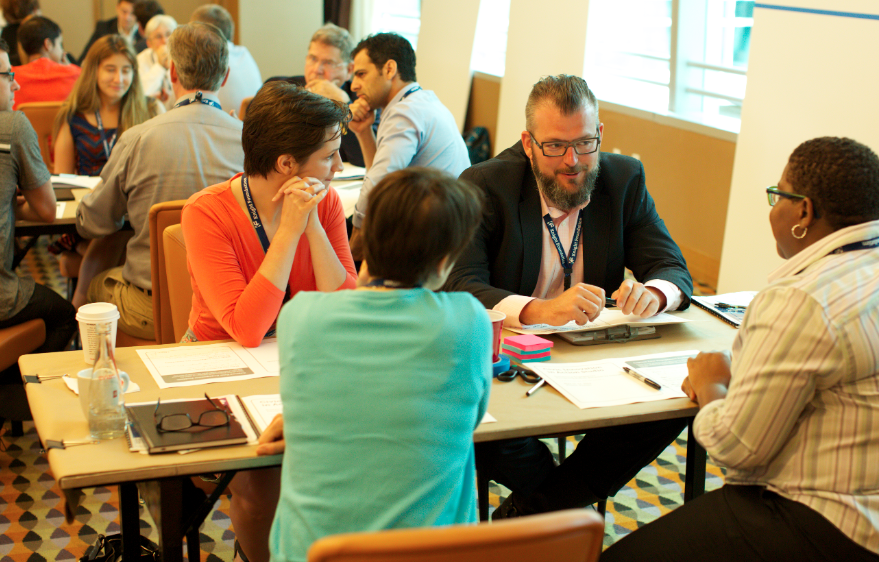
Innovators embrace broad themes of robust engagement
Photo credit: Tom Clark.
The engagement was robust on the first day of the Civic Innovation in Action Studio on encouraging robust civic engagement; so much so that the participants reshaped the program mid-afternoon. RELATED LINKS
“Putting ideas into action to build better cities” by Carol Coletta on KnightBlog
“Learning Lab gathers ideas on promoting community engagement” by Carol Coletta on KnightBlog
“Learning Lab gathers ideas on making the most of talent in our cities” by Carol Coletta on KnightBlog
“Boston adopts new tools to engage residents in civic life” by Nigel Jacobs on KnightBlog
“Scaling an Etsy Economy for a changing workforce” by Dana Mauriello on KnightBlog
“Harriet Tregoning, identifying ideas to expand opportunities in cities” by Carol Coletta KnightBlog
“Encouraging more robuts acts of citizenship” by Adam Royalty and Scott Witthoft on KnightBlog
“Studio explores ideas for successful cities” by Carol Coletta on KnightBlog
“Civic innovators gather in Miami to build ideas for successful cities” by Michael Bolden on KnightBlog
“Studio developing ideas on advancing to harness talent of a changing workforce” by Anusha Alikhan on KnightBlog
It was the kind of engagement that many of the participants – leaders from city government, academia, community development, polling firms and more – would have liked to see more of in their home constituencies. During morning small-group sessions, the challenge of engaging a diverse cross-section of their communities in activities from city planning to education to voting emerged repeatedly.
The facilitators, from Stanford University’s d.school, encouraged them to design approaches that were small-scale and tangible to start engagement and build momentum. As they covered worksheets and Post-it notes trickled down whiteboards, no magic bullet for engaging the disengaged emerged, but some strong programmatic ideas did.
Some of the most concrete involved community-institution connections, such as using a university to scale local ideas, reinforced by civic classes in vacant lots and community centers, and university classrooms turned over to non-traditional students from the community. Similarly, an idea explored using hospital space for physical fitness and healthy food.
An elegant, if still abstract idea, involved the creation of a “civic method” that could be taught to children just like the scientific method, so they could get into the habit of positively affecting their communities early.
By mid-afternoon, however, the participants made clear that they felt they could add the most value by jumping straight to the broader themes around robust engagement. They convinced the facilitators to drop the focus on individual projects, and rearranged their chairs in new groups.
Knight’s VP for community and national initiatives, Carol Coletta, embraced this design-style iteration, and reaffirmed that the goal of the track was to produce ideas, innovations or experiments aimed to make engagement “general.”
“Engagement is all the things we do to make civil society better,” she said, citing examples from voting to picking up trash in the park to joining a homeowner’s association. “The problem is, engagement isn’t normal. It’s not the default. What could we do to make robust acts of citizenship normal?”
The ideas that came out of the day’s final, grassroots session were robust, and set the agenda for Wednesday’s discussion. One group started with the why of engagement: It’s ethical for people to participate in their own governance; it mitigates uncertainty; it builds resilience and trust in communities; it offsets inequity; it’s efficient.
The others concentrated on the ecology of engagement, with themes emerging:
- Develop practices to change civic behavior on the cognitive level to be more participatory
- Invest in civic infrastructure to offset the divisive effects of demographics
- Identify the principles for construction of engagement, from demystification to food
- Use both shared identity and structures to empower people to take action.
- Those ideas and others were to be refined Wednesday – unless the plan changes.
“Thank you for the revolution,” one of the facilitators said in closing.
Andrew Sherry is vice president of communications at Knight Foundation.
Recent Content
-
Communitiesarticle ·
-
Communitiesarticle ·
-
Communitiesarticle ·


